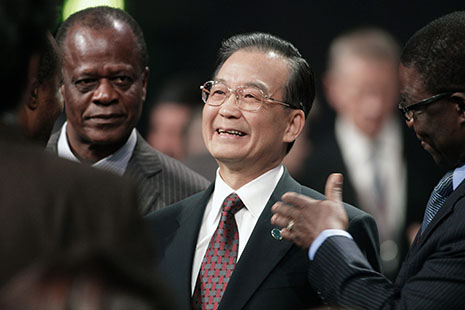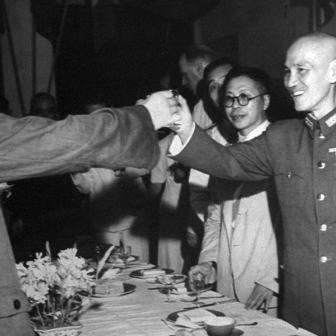After China made a significant commitment in September last year to curb its carbon emissions, the world seemed closer than ever to an agreement on combating climate change. At a UN General Assembly meeting in New York, president Hu Jintao promised a “notable” reduction in the carbon intensity of the Chinese economy by 2020; although he offered no targets, it was a significant shift in China’s position. In late November China went further, announcing plans to reduce the carbon intensity of its economy by between 40 and 45 per cent by 2020.
A month later Copenhagen ended in disappointment and acrimony. Some commentators have portrayed the outcome as a stitch-up between the United States and China or the result of the still inadequate commitments offered by the United States. Others have argued that the conference never recovered from the leaking of a compromise text developed by the Danish conference chairs during the first week. But all the evidence supports the criticisms of China made by the British environment minister Ed Miliband and the writer Mark Lynas (an adviser to the Maldives at Copenhagen): that China and its allies used procedural tactics to prevent negotiation throughout the second week of the conference and then, in the final hours, blocked attempts to include specific targets and removed a clause establishing a negotiation process towards a legally binding treaty.
The behaviour of China in Copenhagen puzzled and surprised many developed country delegations. Extensive discussions with the Chinese government over the months leading up to the conference had led them to believe that China wanted a deal. Yet from the opening days of the conference the Chinese delegation, in concert with its Sudanese allies, appeared determined to prevent the Danish chair from establishing a realistic negotiation process. Given the difficulties in conducting talks among 192 countries it is normal practice at large-scale conferences for a small representative group to handle the detailed negotiations and then report back to the whole; China and Sudan refused to allow this to happen at Copenhagen.
This is why the conference ended with the spectacle of a group of world leaders negotiating the text themselves in order to salvage an agreement. Invited to this meeting were the leaders of all the world’s major economies, including the United States, Japan, the European Union, Russia, China, India, Brazil, South Africa, Korea, Mexico and Indonesia, together with the chairs and representatives of major developing country groupings including Sudan, Bangladesh, Lesotho, Ethiopia, Algeria, Saudi Arabia, the Maldives and Colombia. Yet the leaders found themselves negotiating not with Premier Wen Jiabao, who remained in a separate room nearby and then in his hotel, but with He Yafei, the Chinese vice-minister of foreign affairs, and at other times with a middle-ranking official from the Chinese foreign ministry.
During that last day the Chinese insisted that the target for industrialised countries – an 80 per cent cut in emissions by 2050 – be dropped from the agreement. The overall target of a 50 per cent cut by 2050 was also removed at China’s insistence. And, supported by India, Brazil and South Africa, China said that it could not accept the paragraph committing to further negotiations towards a legally binding treaty. While there are legitimate questions about the fairness of the targets for developing countries, it seems clear that China was determined to avoid having its hands tied in any way at the conference.
If China – which is now the largest emitter of greenhouse gases – did no better than the 40 to 45 per cent reduction it promised in November, then it would simply slow down an inevitable increase in global temperatures. But the paradox of Copenhagen is that China has been taking very serious action to curb its emissions growth in its current five-year development plan. The turning point, according to a long report in the New Yorker magazine last month, came in 2006, when the Chinese government accelerated its clean-energy research and development efforts. “China doubled its wind-power capacity that year,” writes Evan Osnos, “then doubled it again the next year, and the year after. The country had virtually no solar industry in 2003; five years later, it was manufacturing more solar cells than any other country, winning customers from foreign companies that had invented the technology in the first place.” David Sandalow, the US assistant secretary of energy for policy and affairs, told Osnos that China’s investment in clean energy was “extraordinary.”
It is generally agreed that China is on course to meet a 20 per cent improvement in energy efficiency during 2005–10, having closed large numbers of inefficient power plants and factories. It is also making rapid progress towards its 15 per cent renewable energy target by 2020. Indeed, China’s own energy research institute suggests that such policies are likely to achieve a 50–55 per cent improvement in carbon intensity by 2020 rather than the 40–45 per cent target set by the government in November.
A range of factors contributed to this shift in domestic Chinese policy, including the increasing (and economically and socially costly) pollution associated with coal-fired electricity stations and fears about energy security in a country that has gone from being a net oil exporter to a large-scale importer. Coal will continue to be an enormous problem, however, and government-funded experiments, combining American technology and Chinese manufacturing, are chasing the elusive goal of low-emissions coal-fired energy production. China is also acutely aware of the huge emerging global market in low carbon technologies, and is already an exporter of wind turbines and solar panels.
From outside the intense and emotional atmosphere of the closing hours of the conference it’s easier to see why China might have behaved the way it did during the negotiations. It seems likely that the overwhelming motivation was a fear that, once it moves into the category of developed countries, it too would be constrained by an 80 per cent target. History undoubtedly played a part as well – not just the long history of western industrialisation and its climate impact, but also the recent history of America’s effective withdrawal from and then return to climate discussions.
The Chinese government might also have reacted badly to pressure from European leaders during the conference to make a more generous emissions reduction offer and contribute to the fund for climate change mitigation in developing countries. But the journalist Jonathan Fenby, a long-term observer of the Chinese leadership, argues that China’s position “would have been set out in advance and approved by the standing committee of the politburo. Wen could not deviate from that, even if he had been minded to do so…”
Understanding exactly why the Chinese government acted as it did is difficult given the nature of decision-making processes in Beijing. The developed countries knew exactly what was happening in the US congress, and could make allowances for Barack Obama on the basis of their grasp of the domestic forces ranged against him. They weren’t surprised when the US negotiators arrived in Copenhagen with an offer that fell well short of their own positions. It’s quite possible that a debate just as polarised had been taking place in Beijing, given the ongoing battle between the “resilient” and “rigid” tendencies within the upper echelons of the Communist Party – terms used recently by the Chinese sociologist Yu Jianrong.
WHAT we do know is that China is pursuing a strategy – part economic, part diplomatic – that could have an enormous impact on relations over the next few decades. That changed landscape could significantly influence efforts to reduce greenhouse emissions.
The Copenhagen negotiations provided an insight into how relatively new networks of economic and political relations are beginning to have an impact in the sphere. The roles taken by Sudan and Ethiopia at the conference illustrate this well. Sudan’s representative was Lumumba Di-aping, who was a key player in the procedural obstruction that helped stop the conference from making progress over its first week and a half. Sudan currently chairs the G77, but it is also close to China, one of the few major nations prepared to deal with the regime in Khartoum. At Copenhagen those two affiliations became blurred.
Ethiopia, meanwhile, has been closer to the English-speaking west, as a willing participant in the war on terror and as US-backed invader of Somalia in late 2006. Prime minister Meles Zenawi, who had led a walkout out by developing country delegates at a preparatory meeting for the conference in Barcelona, changed direction at Copenhagen by proposing a fund, worth US$100 billion by 2020, to help developing countries adjust to climate change. Seen as too timid by many developing countries, the proposal closely reflected Europe’s adjustment plan, which was endorsed (late in the conference) by the United States.
But Ethiopia’s allegiances are beginning to shift, according to the authors of China Safari, French journalists Serge Michel and Michel Beuret. “China and the United States are locked in a battle for influence there,” they write. “Not only has China invested a great deal of money in Ethiopia, building roads, dams, and communication networks, but as a result it also has an eye on the oil underneath the region’s deserts.” Ethiopia is not alone; the extent of China’s push into Africa – driven both by the government in Beijing and by individual Chinese entrepreneurs, businesses and agencies, whose interests don’t necessarily coincide – is reflected in an enormous growth in economic relations. According to the Trade Law Centre for Southern Africa, trade between China and Africa increased by 45 per cent between 2007 and 2008, bringing the total to approximately US$106 billion and confirming China’s status as Africa’s second most important trading partner after the United States.
By aggressively investing in developing countries, particularly in Africa, China is building a network of relationships that look a little like the alliances created by the United States and the Soviet Union during the Cold War, and maintained since then, particularly by the United States, in a less explicitly ideological framework. But the times are different and China’s goals are different and complex, which makes any analysis of the likely impact of these developments tentative at best. China is looking for several things simultaneously: for resources (particularly oil), for investment opportunities, for support in its efforts to reintegrate Taiwan, for recognition as leader of the developing world and for new markets for its exports. And it is doing so in a period in which, it’s increasingly argued, developing countries need to put more emphasis on trading relationships and less on aid.
Adding to the complexity is the fact that the Chinese are offering packages of aid and investment that open up regions and link economies poorly served by existing infrastructure. The results could be significant. Earlier this month, for example, the Financial Times reported that China had “signalled its interest in funding part of a multi-billion-dollar Kenyan project to develop a port and transport corridor that could provide a new export route for Chinese oil from Sudan.” According to the FT, this new export route could help break Southern Sudan’s dependence on pipelines that transport its oil to refineries and a port in the north. Freeing the south from that dependency could change the dynamics of the current peace process to the south’s advantage.
Trade between Africa and China mostly involves a flow of raw materials – mainly oil – from Africa, and a flow of manufactured goods in the opposite direction. This pattern of trade creates the conditions for a further round of the “resource curse” that has blighted African countries rich in resources, poorly governed and commercially weak. The rivers of foreign currency generated by a single resource – usually oil or diamonds in Africa – flood the local market, driving up the currency and generating an influx of goods. These cheap imports swamp local manufacturers, undermining the prospect of a balanced, sustainable economy.
The Chinese presence has also attracted criticism and sometimes violence within countries like Zambia (where the Chinese workforce that often accompanies Chinese investment created ill-feeling among local workers) and Nigeria (where Chinese oil workers have been targeted alongside other nationalities by the Movement for the Emancipation of the Niger Delta). As the political scientist Ian Taylor writes in his book China’s New Role in Africa, “violations of environmental law and hazardous conditions for workers are the norm in much of China. It can therefore be no surprise that similar circumstances develop overseas.”
China’s willingness to overlook the behaviour of repressive regimes when it makes investment and aid decisions means that governance and human rights could deteriorate in these countries. Taylor argues that China’s impact on the quality of government has been mixed. “There are instances in which China’s role in Africa is clearly positive and appreciated; conversely, there are instances in which Beijing plays an equivocal role, one that arguably threatens to unravel some of the progress Africa has made on issues of good governance and accountability.” It very much depends on the quality of the particular African government the Chinese interests are dealing with. Above all, Taylor writes, the Chinese government and Chinese companies are interested in stability – which led, for example, to a cooling of their support for Robert Mugabe’s increasingly erratic regime when Zimbabwe’s economy dramatically worsened in 2005.
But the fact that China works with regimes that clearly infringe human rights norms is indisputable. In some cases this involves supplying arms, uniforms and other military support to the governments of fragile or poorly run countries; in other cases, it means that China provides civilian aid or investment without imposing any conditions relating to political or human rights. To a large extent, that approach mirrors the longstanding practices of many developed countries and European and American companies in Africa, but China’s willingness to go a step further and deal with pariah states has attracted wide criticism.
Ian Taylor’s book is intended as a corrective to panicky responses to China’s growing interests in Africa. He discusses the human rights problems, for example, but also points out that China has sent over 7000 peacekeepers to Africa since 1990 and has contributed financially to UN peacekeeping efforts. Writing in 2008, he says, “There are both positive and negative aspects to Sino-African ties as they appear in the 2000s, but Chinese policy toward Africa is constantly evolving, and since about 2005, Beijing has clearly been rethinking its policies toward so-called pariah regimes.”
The increasing Chinese presence comes at an important time for Africa. Continent-wide, the first decade of the twenty-first century has been a period of stronger economic growth and a significant increase in the number of countries with some form of democratic government. The improved economic performance of many African countries was threatened by the global financial crisis, but stimulatory spending in China could help take the edge off the downturn – though it won’t bring about more balanced trade. But China is looking for many things – including support in forums like the Copenhagen conference – in return. In the words of an anonymous African quoted in China Safari, “Right now we need our leaders to be very, very wise.”
MEANWHILE, the Copenhagen conference isn’t entirely over. The Copenhagen Accord hammered out on the final day was simply “noted” by the conference as a whole; countries are now being asked to “associate” with it individually. Those that do have until 31 January to attach their carbon-reduction commitments. Only once countries have signed up and the commitments been entered will the accord take shape.
Will China simply enter its 40–45 per cent target at the end of this month, or will it also set out the underlying policies that have the potential to achieve significantly more? In its actions might lie the answer to the question of whether China is willing to cooperate in the collective global project of combating climate change after Copenhagen, or whether it has decided to abandon it in favour of a more nationalistic global stance. •




